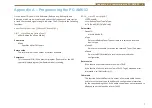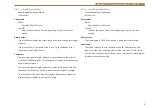
2
1 Installation
Specifications
Tuning range:
500kHz to 1710kHz in 1kHz steps
Sensitivity:
50uV for 40dB S/N
Maximum input level:
200mVp-p
Z&ŝŶƉƵƚŝŵƉĞĚĂŶĐĞ͗
ϱϬɏ
Filter attenuation:
82dB at 15kHz or more from centre frequency
Audio bandwidth:
5kHz (wide) or 3kHz (narrow)
Audio distortion:
< 0.1%
Audio sampling rate:
22.05 kHz (other rates supported via Windows
SRC)
Number of stations:
6, 12, 18, 24 or 32 (factory configured but user-
expandable)
Installation
The AM Radcap card uses static-sensitive components. Observe the usual
precautions against static electricity when handling the card and do not
touch the PCIe edge connector contacts.
Ensure that Windows XP (SP2 or later), Server 2003, Server 2008, Vista, 7,
Server 2008-2, 8 or Server 2012 is installed on the PC. The AM Radcap card
cannot be used under Windows 9x or Windows ME, 2000 and versions of
XP prior to SP2. The latest Service Pack should be installed.
Switch off the PC and unplug the power lead. Insert the card into any vacant
PCIe slot. Although the card is single-lane, it can be used in multi-lane slots
as the PCIe protocol automatically negotiates lane width.
Restart the PC and allow Windows to boot up.
Windows XP, Server 2003, Vista, Server 2008
- Windows will report that
new hardware has been found and the New Hardware wizard will start.
Insert the driver CD supplied with the card and proceed through the wizard.
Allow Windows to search for the driver – do NOT specify a driver location
or file name.
Windows 8, 7, Server 2012, Server 2008-R2
– Windows no longer searches
removable media for drivers. Open Device Manager, where the Radcap will
be shown under Other Devices as a Multimedia Audio Controller. Right-click
on it, select Update Driver Software, then click on Browse my computer for
driver software and click on the Browse button to navigate to the driver’s
location. Click on Next to install the driver.
Windows may warn that the driver that it is installing has not been certified
by Microsoft, which is true. The driver is however digitally signed by Innes
Corporation to meet the requirements of 64-bit Windows Vista and later
systems. Click on Continue to complete the installation.
Antenna
The AM Radcap requires an external antenna to receive the stations. The
type of antenna needed depends on the signal levels in the area in which
ŝƚŝƐďĞŝŶŐƵƐĞĚ͘dŚĞĐĂƌĚŚĂƐĂůŽǁŝŶƉƵƚŝŵƉĞĚĂŶĐĞ;ϱϬɏͿĂŶĚŝƐďĞƚƚĞƌ
suited to a loop antenna than a whip antenna, although the latter can be
used. An amplified antenna may be needed in some situations.
As a guide, a whip antenna one metre in length at a distance of 10km from
a 5kW transmitter at 1MHz will produce a signal level of about 100uV into
the card’s 50 ohm input. A shielded loop antenna enclosing a one square
metre area under the same conditions will produce about 600uV and will
offer better immunity to local electrical noise.
A suitable shielded loop antenna is the Belar model LP-1.
While the card is fitted with an input protection diode, we strongly
recommend fitting an external lightning suppressor to minimise the risk of
damage to the card. If using an amplified antenna, ensure the maximum
input level (200mVp-p) is not exceeded.




















